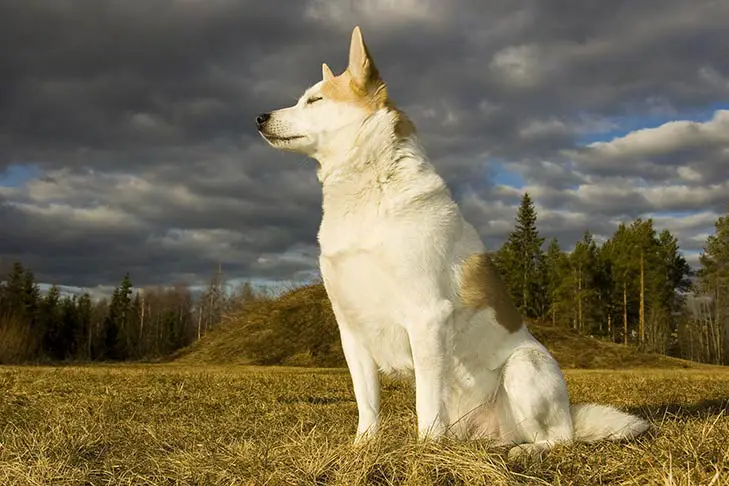The Norrbottenspets is a tiny, slightly rectangular spitz dog with well-balanced, muscular sinew. They are bold and incredibly nimble, alert with their heads held high. They have a gentle demeanor and are composed, sharp, and attentive. Nobs aren’t particularly big canines (a big male stands just around 20 inches tall), but their hard, sinewy physiques are made to handle challenging environments. They are a small-sized Spitz-type hunting dog that was once believed to be extinct but has since flourished as a farm and hunting dog in northern Sweden and Finland. Norrbottenspets developed to be exceptionally agile, tough, waterproof, and brave with a fearless attitude, but at the same time being gentle and lovable companions at home, in order to be able to handle the challenging terrain and climate of the Scandinavian woodlands and hold large dangerous prey, like moose. They don’t have any extreme physical traits because they have to do everything perfectly.
Norrbottenspets
Average sizes and life
expectancy of the breed.
Height
16.5-18 inches
Weight
20-30 pounds
Life Expectancy
14-17 years
Breed Traits & Characteristics
About the Breed

Owning a dog is not just a privilege; it’s a responsibility. They depend on us for, at minimum, food and shelter, and deserve much more. When you take a dog into your life, you need to understand the commitment that dog ownership entails.
 Health
Health
Recommended Health Tests From the National Breed Club:
- Hip Evaluation
- Ophthalmologist Evaluation
 Grooming
Grooming
 Exercise
Exercise
 Training
Training
 Nutrition
Nutrition
History
People in the world’s coldest regions have bred the spitz breed of dog for millennia. Whether they are stocky like the Alaskan Malamute or delicate like the Pomeranian, these Nordic breeds all have characteristics in common with spitz types. These include erect, pointed ears, a tail that is thickly coated and curves tightly over the back, and a wedge-shaped head that typically has a foxlike expression. The Norrbottenspets, pronounced “nor-bo-TEN-spets,” is a members of this venerable group of arctic hunters and laborers.
The Norrbottenspets, also known as the Norrbottenspitz in English, is a small hunting spitz that has persisted for thousands of years due to natural selection. It is from the county of North Bothnia and is thought to have descended from small Laika spitz that were known to coexist with hunters in the North Cape region in prehistoric times. Hunting for food and fur was essential for ensuring one’s life in the extremely harsh regions of the northern parts of the Scandinavian Peninsula. For many years, only valuable furs like sable, marten skin, and ermine served as legal tender. Following World War II, fur prices plummeted, and interest in the Norrbottenspitz followed suit. The breed was declared extinct by the Swedish Kennel Club (SKK) since it no longer existed and had no registrations for many years.
The discovery of several true-to-type animals, however, as pets and watchdogs on small homesteads in the inland region of North Bothnia was reported only ten years later. A small group of men worked really hard to save an old-style hunting spitz. A new standard was created in 1967 and the Norrbottenspitz was reinstated to the Swedish Registry. The Norrbottenspets’ official name was changed once the FCI approved the revised breed standard.
Finns started searching the isolated countryside of North Finland for native dogs that matched the standard to widen the gene pool, as requested by the Swedish Kennel Club. The majority of the foundation canines were successful and were from Finland. In Sweden, the studbook was shut down in the 1980s, but it is still available in Finland. With scattered individuals counted in few tens all over the world, the Norrbottenspets population is roughly 1600 in Sweden and 1300 in Finland.


